“If you buy a cup of tea, then we will plant a tree in your name”. I was pleasantly surprised to hear this at Bascon 3.0. I love my cup of tea and if that helps in making the planet greener, there is nothing like that. There was a stall “Tea for Nature” at the Basar Confluence where you can buy a cup of tea and with that money, they will plant a tree in your name.
To tell the truth, Basar had never been on our radar before. But after our visit there during Bascon 3.0, we realized how beautiful the place is, and why this place should be on every travellers’ list. We visited Basar during the Basar Confluence or Basar Festival; a festival that impresses and inspires.
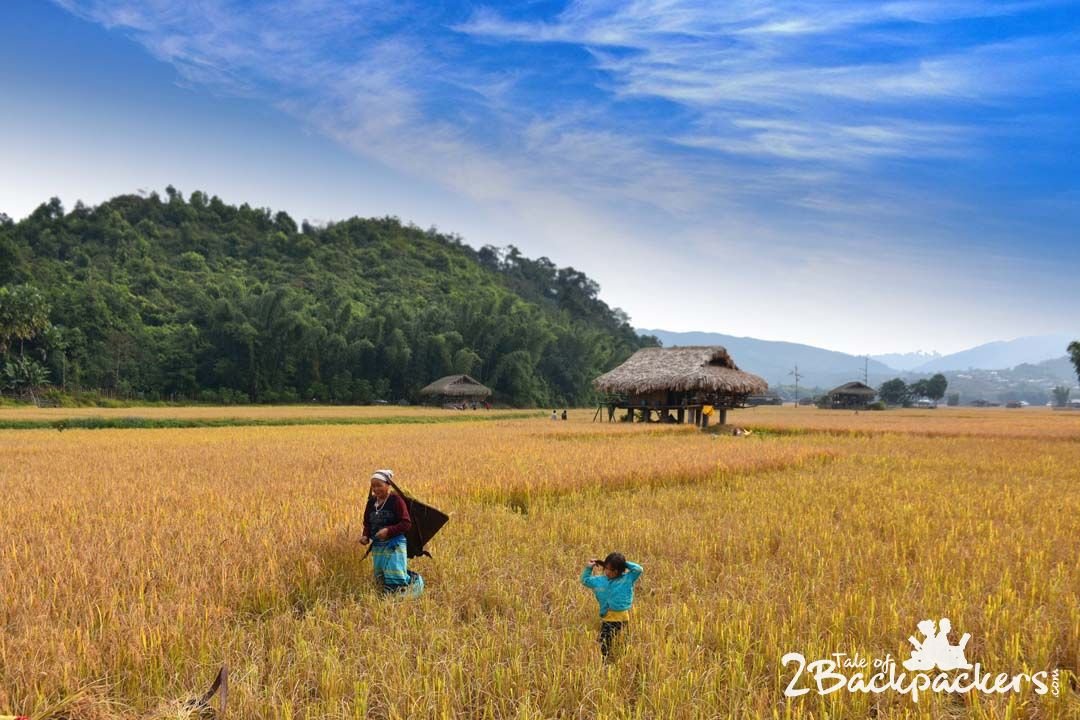

What is Bascon? Is it just another Festival?
Of course not! You cannot just label Bascon just as another festival. Because it is the celebration of traditions, culture, art and life of the Galo tribes who are the residents of Basar. Bascon is the short for Basar Confluence, a three-day annual festival on the initiative of a local non-profit organization Gumin Rego Kilaju (GRK).
Basar Confluence brings together the wisdom of the old and innovations of the new. Bascon is the platform where Basar showcases the traditional art, drama, folk music and dance forms of the Galo and other Arunachal tribes. There is a display of traditional sports as well. In the evenings, there are musical performances to enthral Basar.
Bascon is the time for Basar community to come together. They might be away from Basar because of their profession, but during these few days, they all come together to celebrate.

GRK – the idea behind Bascon
GRK or Gumin Rego Kilaju is an organization formed by the Government officials at Basar and is the silent crusader for sustainable and economic development of the region. GRK is involved in many social activities like conservation, cleaning rivers, banning hunting, sports, counselling and guidance for students among others.
We need to live harmoniously among ourselves while being receptive to others. Mostly we need to live in harmony with nature.
This is the idea behind Bascon or Basar Confluence. Said Mr. Tomo Basar, the President of GRK, while he was interacting with us.
And this idea is integrated very beautifully in the quaint hilly destination of Basar, a place that is usually not on the list of travellers. The GRK members are trying to bring Basar on the tourism map with Bascon at the backdrop. GRK has been working around the villages of Basar and is also the main idea behind the Basar Confluence. The objective of GRK has been very beautifully summarized by their President and incidentally, GRK is also working towards the goal.
Most of the members of GRK whom we met are quite busy and successful in their professional lives. They had found time to come together to organize the extravaganza.
Basar Confluence is organized by its own people with much reverence and love. It is a community effort. Each village had been assigned a particular job and they had done it in the best possible way.
And that is one of the best things about Bascon.

More about Bascon 3.0
When we had heard about Basar Confluence, we knew that we had to be there. Bascon 3.0 was spread across three days and was filled with fun and colours. There were traditional dance, folk music presentations, local jamming sessions and so much more. It was simply a fulfilling experience. We seriously did not know how the three days simply passed by. We were simply mesmerized by the tune of the Galo folk songs while beats of the War Dance made us sway to its rhythm. We tried to hum the soulful music by the music bands and performers. And of course, we enjoyed the local cuisines and drinks. We got to know the Galo way of life from the Live Galo Museum and got involved in farming with the farmers at the Agri Tourism Point. The experience was totally immersive and something that we will not forget any time soon.

Some of the Highlights of Bascon 3.0
Galo Ponu
This is the first spectacle that we saw when we arrived at the Festival grounds. Yes, I would call it a spectacle. Hundreds of Galo women dressed in colourful attires were standing in a huge circle around the ground. Ponu is a local dance form usually performed on various occasions. In this case, it was a welcome dance. The dance can have any number of participants and is conducted by a leader. The Ponu leader narrates the folklore, stories and myths in singing and all the other dancers repeat the refrain after each line. The Ponu leader also holds a sword upside down in her hand and along with singing shakes the sword for rattling sound.
It was indeed a spectacle to watch. Most of the villages in Basar participated in the dance. Each village was represented by a few women and their leader and the villages wore different coloured costumes. It was such a colourful view.

Nyida Parik
Nyida Parik is the Galo wedding dance. Infact, the marriage ceremony is known as ‘Nyida’ in Galo language. It is the dance of the men where they dressed in black and white performed the rhythmic dance that resonated with the beating of the metal plates. The Galos believed that this dance was first performed during the marriage of Abo-Tani (the father of all human beings) and Donyi Mumsi, the daughter of Donyi Polo, Sun god. With their eye-catching headdresses, the men performed the dance with elan as the onlookers cheered from around. And we were simply awestruck by such a grand scene.

Mega Galo dance
The Mega Galo Dance is actually mega, magnificent. Almost 200 women dressed in all coulourful attires were on the ground performing to the addictive tune of a Galo number. This dance was undoubtedly the most colourful event of the entire festival. The Galo women clearly displayed their grace and teamwork in this beautiful dance. The sheer number of dancers and the ambience reminded me of Hundred Drums Wangala Festival in Meghalaya, where 300 dancers dance to the rhythm of 100 drums! The Mega Galo Dance performance was as stunning!

Mopin Showcase
Mopin Festival is one of the major festivals of the Galo tribe. Mopin is celebrated especially as a pre-agricultural festival usually during March or April so that people be bestowed with a good harvest. Mopin worships the Mopin Ane deity, who is the embodiment of wealth and prosperity for the Galo tribe. She is the protector as well as the bestower. Mopin Ane deity can be compared to Goddess Lakshmi and Goddess Annapurna from Hinduism. While watching the Mopin showcase at Bascon, we also heard the stories about the rituals of Mopin. May be, we will write a post about it after we witness the Mopin Festival!
Bascon gave us a teaser of the Mopin Festival. As the deities arrived in a raft on the river bank, they were welcomed by a group of dancers all dressed in pristine white. The deities were worshipped and the men and women performed dance rituals as a part of the Mopin showcase. We got a glimpse of Mopin in November.
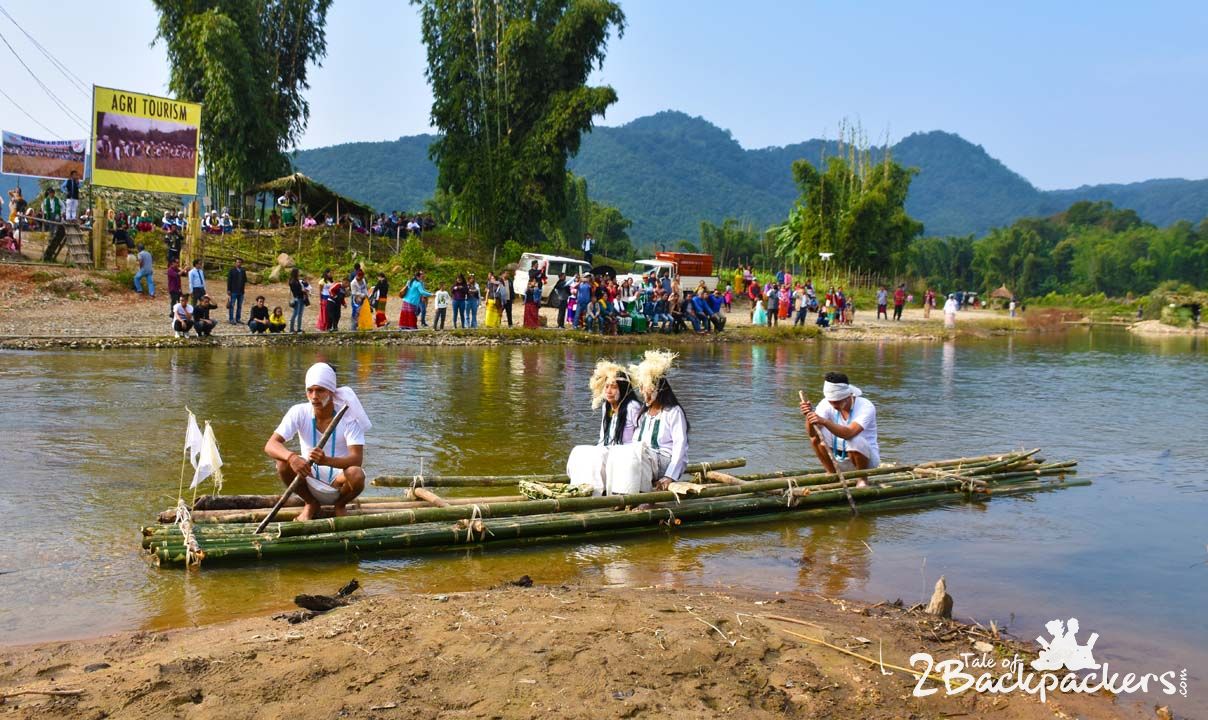
Lion Dance
The Lion Dance was performed by the artists of Tawang. I had previously watched the lion dance in the Chinese New Year, but this was beyond my imagination. So awestruck were we with the performance, that we forgot everything for a while. Amidst pulsating music, came the two snow lions followed by the saint. There is an interesting story behind the snow lion dance. There was once a Lama who had gone to the mountains to meditate. Two snow lions were impressed by his meditation and resolution, that they offered him their milk to sustain his life. This story and the dance shows the harmony between man, animal and nature. The lions were later followed by a peacock in the dance. Two men were inside the lion costume and they were dancing together in perfect synchronization. What a performance it was!

Traditional Fishing Day
The second morning of the Bascon 3.0 was reserved for the traditional fishing day. The Galos have a unique way of catching fish from the rivers. The entire village comes together for fishing.
For catching the freshwater fishes, the villagers stack stones of different sizes on the riverbed. A barrier of boulders is placed on the upstream side of the river so as to reduce the flow of water currents. They also prepare a mesh like structure from split bamboo and place them on stones on the riverbed. The particular portion of the river, which the villagers use for harvesting fishes, is in fact divided into three parts. The mesh is of different sizes, so fishes of various sizes can pass through the mesh.
The part where the small fishes are mainly found, the women of the village put basket like a trap on the river bed to catch the fishes. It is a conical shaped bamboo sieve basket. There is an opening at the side of the trap with bamboo strip extended inwards. The fish can easily enter the trap, but the extended bamboo strips prevent them from escaping. The bigger fishes are on the other side. These fishes are poisoned using some local herbs. The fishes are not killed, but their mobility is hindered. These fishes are then caught by the men using a long bamboo stick attached with a sharp object at one end.


At Basar, fishing is now banned to preserve the different species of fishes. But during Bascon, one day is kept aside for traditional fishing. In this way, GRK aims to introduce the younger generation to the traditional and sustainable ways of fishing.
Traditional Sports Competition
This was another interesting event at Bascon and had all the crowds cheering and shouting. The Galo people take pride in their traditional sports. Archery, acrobatics and a few other sports were part of the competition and had the full support of all the villages. Nyarka hinam is an interesting game where the two participants had to wrestle each other with a bamboo pole within a circle. The one who gets thrown out of the circle loses. The traditional archery is called Geppe Abnam where the participants aimed and shot at still and moving targets. In Baabo Renam, one had to swing on a tight rope. And this one was quite entertaining and interesting. But the noisiest of the lost was perhaps the tug-of-war match, that we too watched with great enthusiasm.


Artist Residency
Another very fascinating aspect of Bascon is the Artist’s Residency. Artists from various spheres are invited at Basar to live there for almost a month and have an experience of the life at Basar. At the end of their stay, which culminates at Bascon, the artists display their artworks at the Bascon. This year, Bascon had Imon Raza, a communications designer, artist, and filmmaker, Mridul Kanti Goswami, a photographer from Bangladesh, Subhash Maskara, a filmmaker from Mumbai, Rakesh Roy Choudhury, a painter from Guwahati, Ranju Dodum, a journalist from Itanagar and Dara Okat (Premjit Ramachandran), a musician. Their stay at Basar was captured in their art. While Dara Okat involved school girls with his music, we saw Basar through the eyes of Subhas Maskara (he did a splendid video on Basar) and Mridul Kanti Goswami (through his photographs).

Music
What is a festival without music? Bascon 3.0 was resplendent with the folk songs and dances. The artists line up also comprised of noted contemporary musicians as well. There are local jamming sessions and the cold evenings were totally alive with the music performances by various bands and local musicians as well as performances by Barmer Brothers and Fiddlers’ Green.
While the temperature dipped in the evening and the mist settled by the riverside, the people and viewers were mesmerized with the music performances. The cheer and shout of the youths seem to resonate in the air as the artists performed their soulful renditions. We were quite impressed by the soulful music by Dr. Nikom Riba, Jeli and his Band and the local heartthrob Mojum Riram. Music has no language and we totally agreed to it as we swayed to the tune and rhythm of the famous ‘O Delo’ number.

Dance & Drama
Apart from the one we mentioned, there were other Galo folk dances like the War dances, Memba dance, Tripura and Manipuri folk dance and Bihu dance. On Day 2, there was a theatre performance that enthralled the audiences quite much. Although we could not understand the language, we knew it to be a terrific performance. The audience were in splits while the drama was on.


And there were more at Bascon 3.0
Agri & Textile Tourism
Agriculture is one of the major livelihoods of the villagers. At Bascon, a separate area was designated to showcase the ways and means of agriculture of the Galo tribe. They demonstrated the way they cultivated paddy, and how they extracted rice and made other food items from rice. The visitors could get the first-hand experience on farming at Basar.
Likewise, there was a textile tourism corner where weaving and textile making were demonstrated. Visitors can also buy the dresses from these shops.

Storytelling
The Galo tribes have a rich history and culture mostly based on oral literature. It was quite interesting to know about their traditions and history by the elders of the village. We always love stories about places and at Basar, there were no dearth of that. There was a separate storytelling stall at the Bascon where you could hear fascinating stories about the land and the tribes.
Adventure at Bascon
Apart from all the cultural events, the visitors can also go for bird watching and trekking to different places at Basar. You can also go cycling and there was also the option for camping at the riverside.
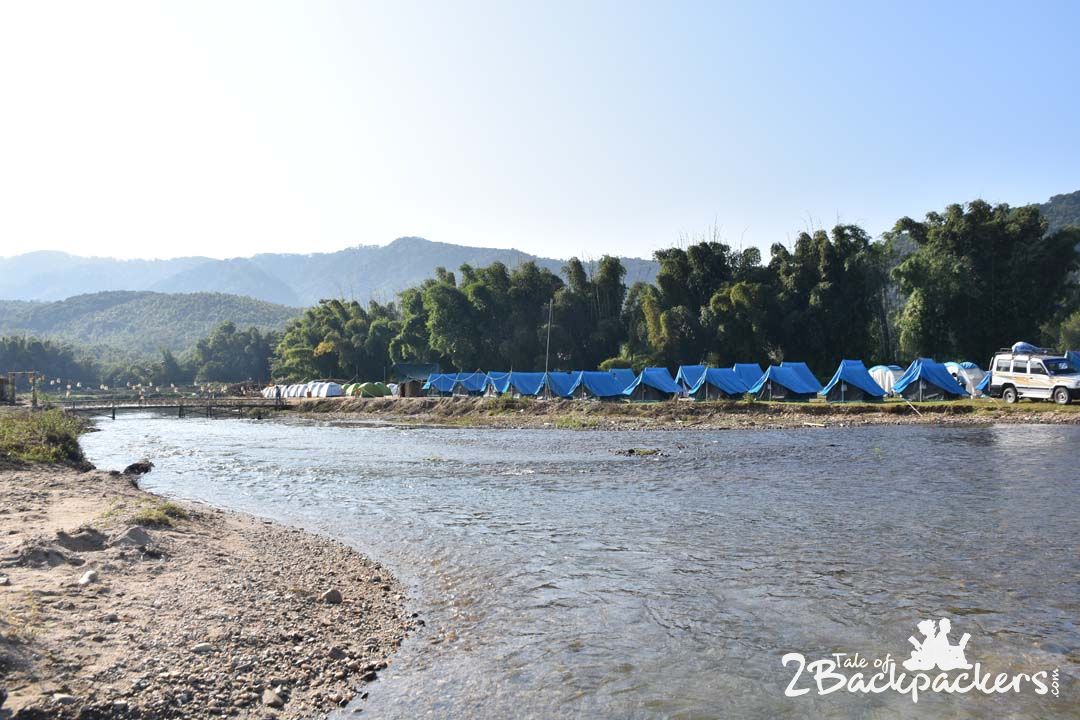
Cuisines
Food forms a major part of festivals and Bascon was no exception. There were multiple food stalls from different villages with their delectable local cuisines. Food cooked in the traditional Galo way inside bamboo stems were served and so were exotic dishes of the community. Those who love to experiment and be adventurous with food would have a gala time there.
And then there were drinks! Local alcohol, mainly known as “Poka” were available at almost every shops and you can have a swig at poka in a bamboo stem! Infact, we had tea in a small bamboo glass.
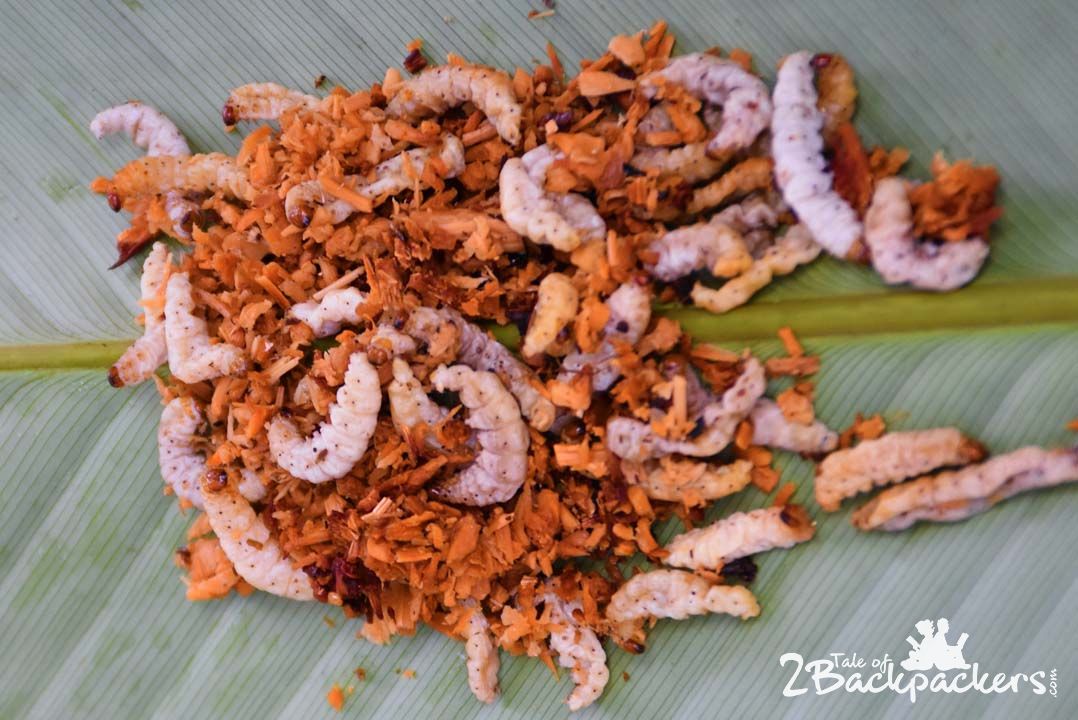
Basar Confluence (Bascon) – a green initiative towards sustainable tourism
Bascon 3.0 was in total harmony with nature. Just as the GRK President was telling us about his vision about living harmoniously, we actually saw his ideas in action.
Bascon was totally a plastic-free zone.
No one was allowed to take plastics, even water bottles inside the venue. You will not see any plastic anywhere. The stages, seating arrangements and bridges, everything was made of bamboo and leaves. The food is served on leaves. Water is served in bamboo containers and so is the local alcohol. Bascon is truly a great step towards sustainable and eco-tourism.

Where is Basar?
Basar is located in the newly formed Lepa Rada district of Arunachal Pradesh. Basar is basically a census town with a few villages surrounding the place like Gori, Hoi, Bam, Sago and others.
Basar is located at the confluence on Hei and Kidi Rivers. The confluence of these rivers is also the venue of the Basar confluence, and so comes the name. Basar is picture perfect. The villages have small bamboo huts with orange orchards. You see the stretches of paddy field and farmland and meandering roads. Basar gives a sense of seclusion, yet you will never miss the company of a friend here.
At Basar, you can explore the villages, visit Joli, the haunted place, go for trekking to the waterfall and Bat caves.
How to reach Basar?
Reaching Basar can be a bit of arduous task. The nearest railway station is at Silapathar, also the last town in Assam before you enter Arunachal Pradesh. Basar is a long 5 hours journey from Silapathar through bumpy and narrow roads. Shared Sumos are available from Silapathar to Basar.
From Aalo, Basar is about 50 km and the roads are treacherous in these parts also. Shared sumos are also available to and from Aalo.
Another way to reach Basar is from Dibrugarh, which is also the nearest airport. From Dibrugarh, drive to Bhogibeel and cross the Brahmaputra River. From there, you have to come to Silapathar and then continue your journey towards Basar.
However, once you reach Basar, the charm of the place is sure to drive all the fatigue of the journey. It is difficult not to fall in love with the place.

Our Experience at Basar Confluence (Bascon 3.0)
We fell in love with Basar. Although we stayed at Basar for 3 days at Bam village, we had a lovely time there. Northeast have always welcomed us with open hearts, be it at Tura or Majuli or Mawlyngot. Basar was no different. We were happy to be a part of the Basar family even if it were for a few days. We were happy to be welcomed with open hearts at every house we visited. We loved the stories, the laughter around the shared drinks and the warmth of everyone at Basar.
Bascon too was a unique experience, a carnival that had everything. Just as Mr. Tomo Basar told us “they have to go a long way”. And we are sure they will.

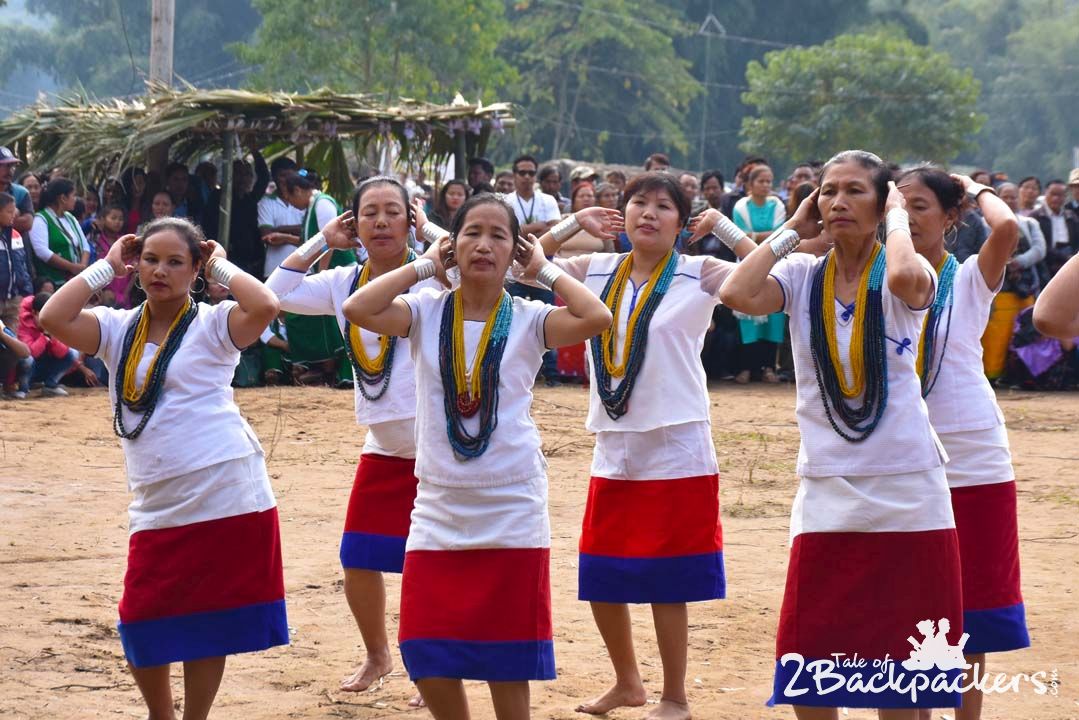


Liked the post? Pin it for a later read.



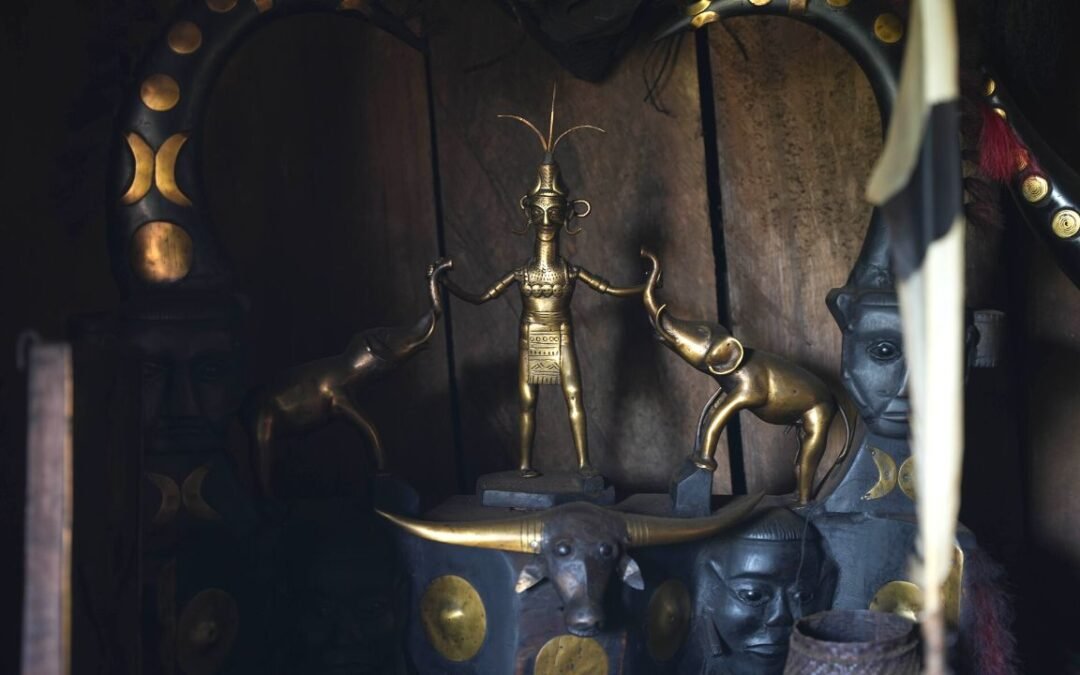
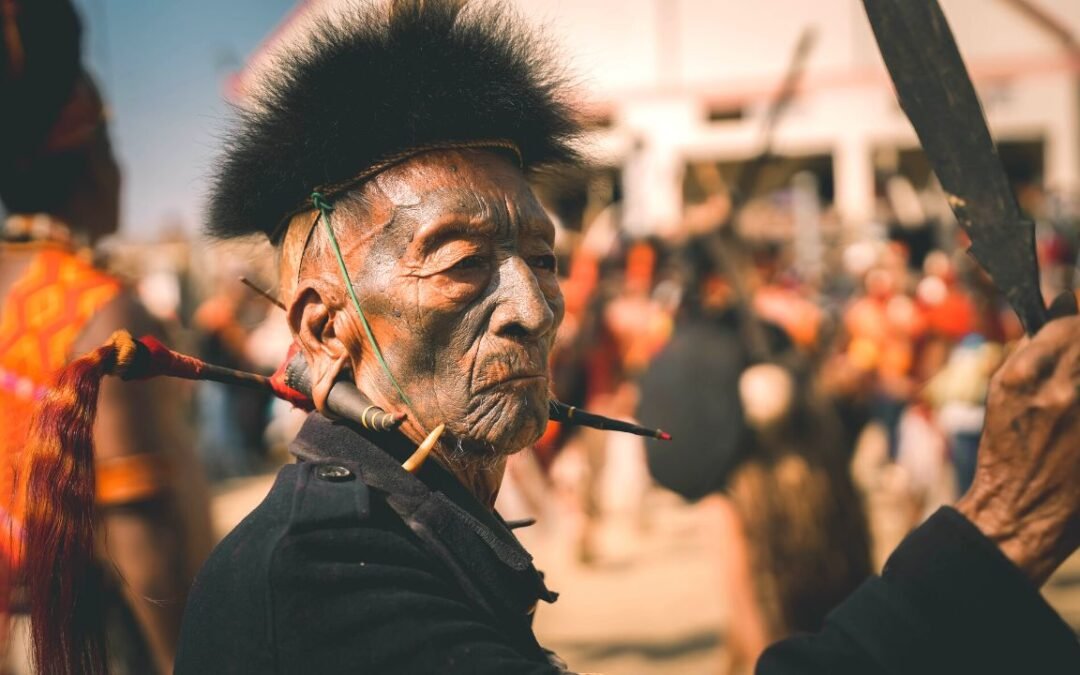
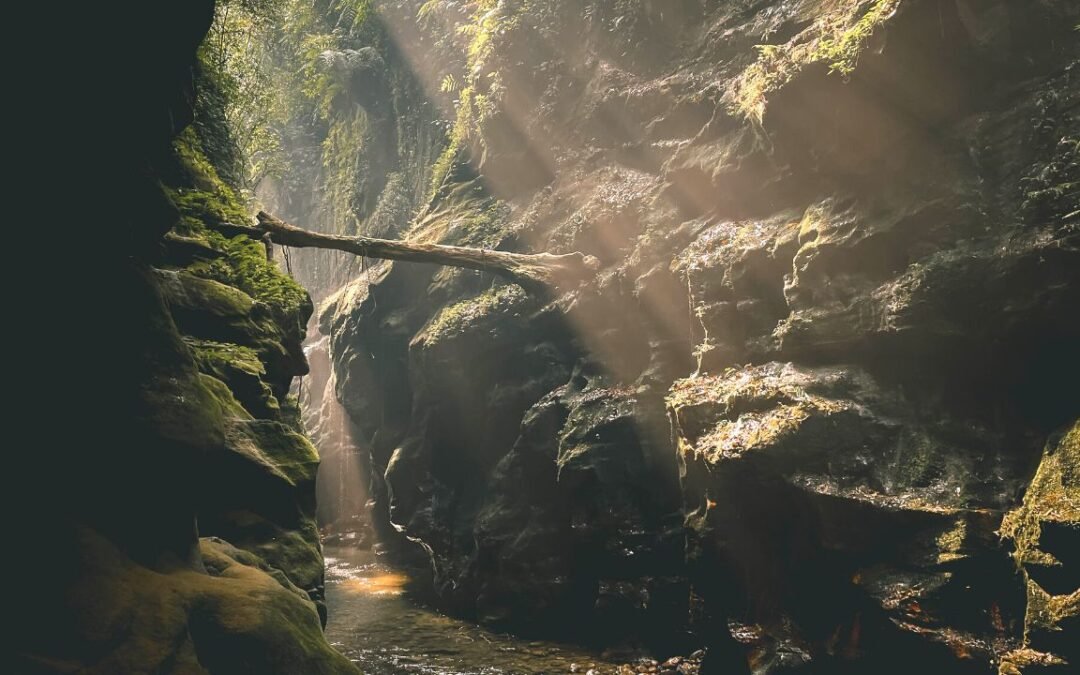
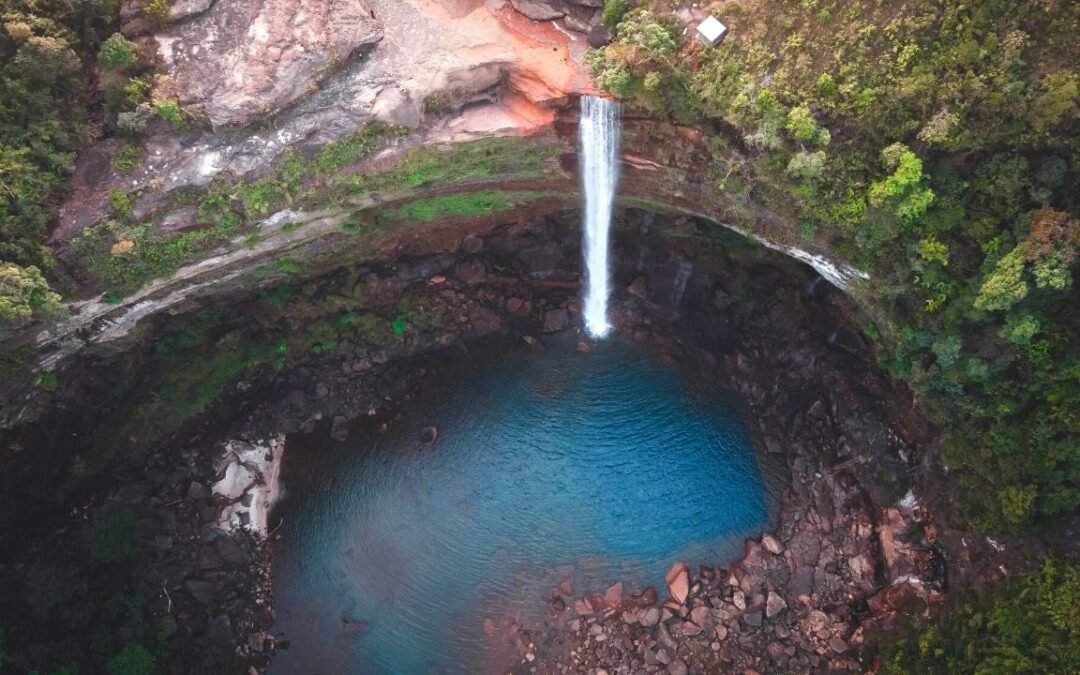
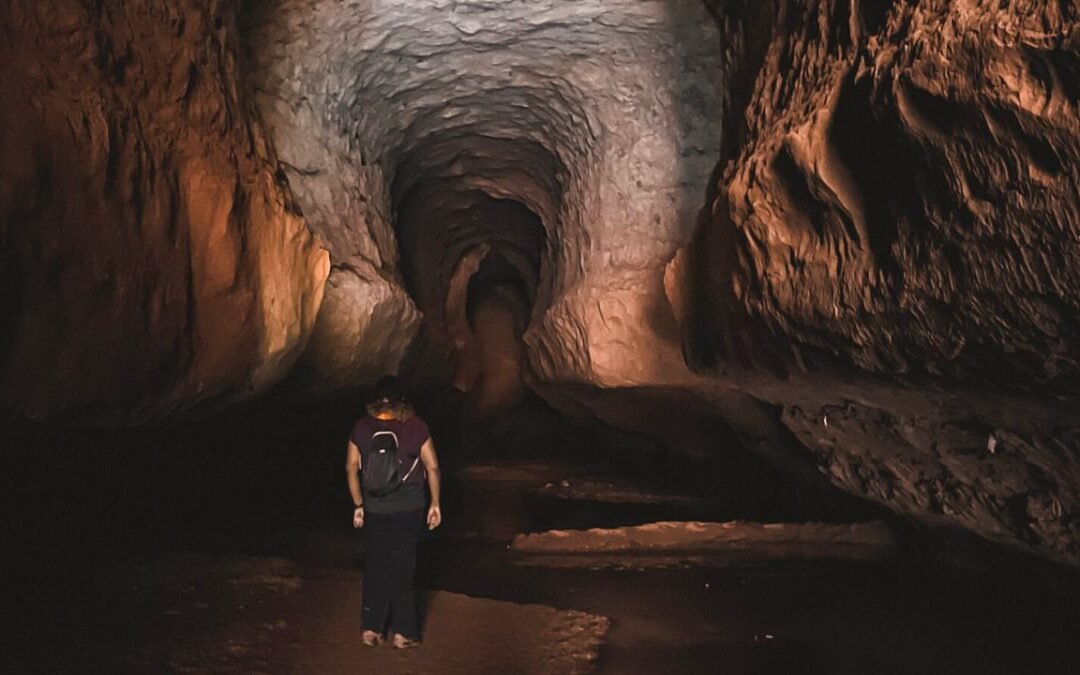
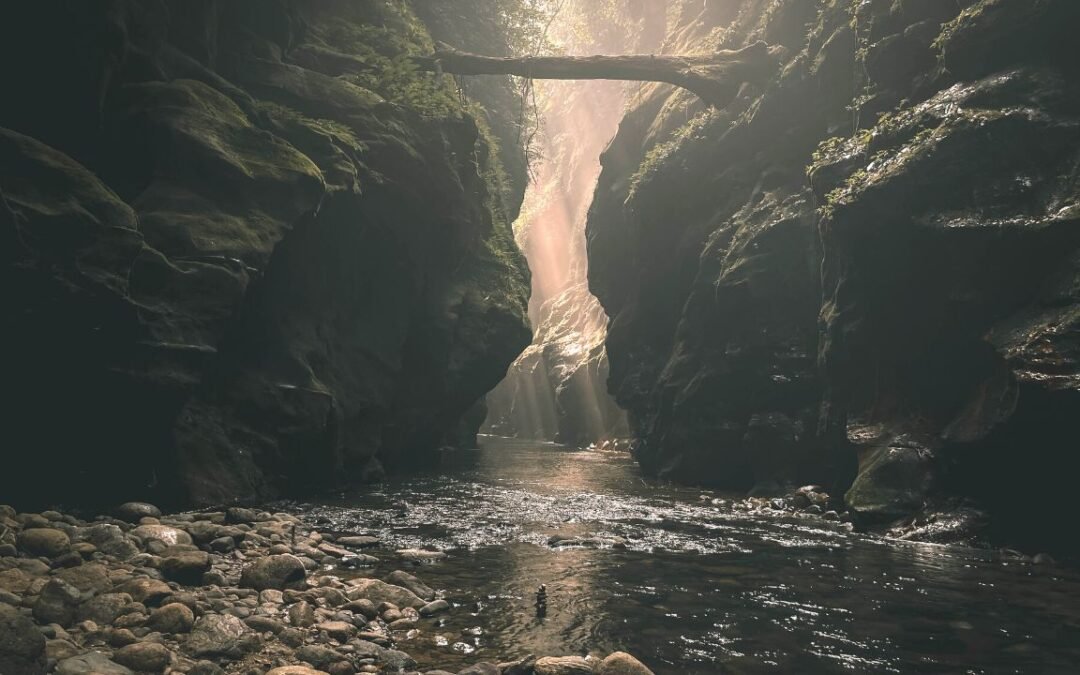
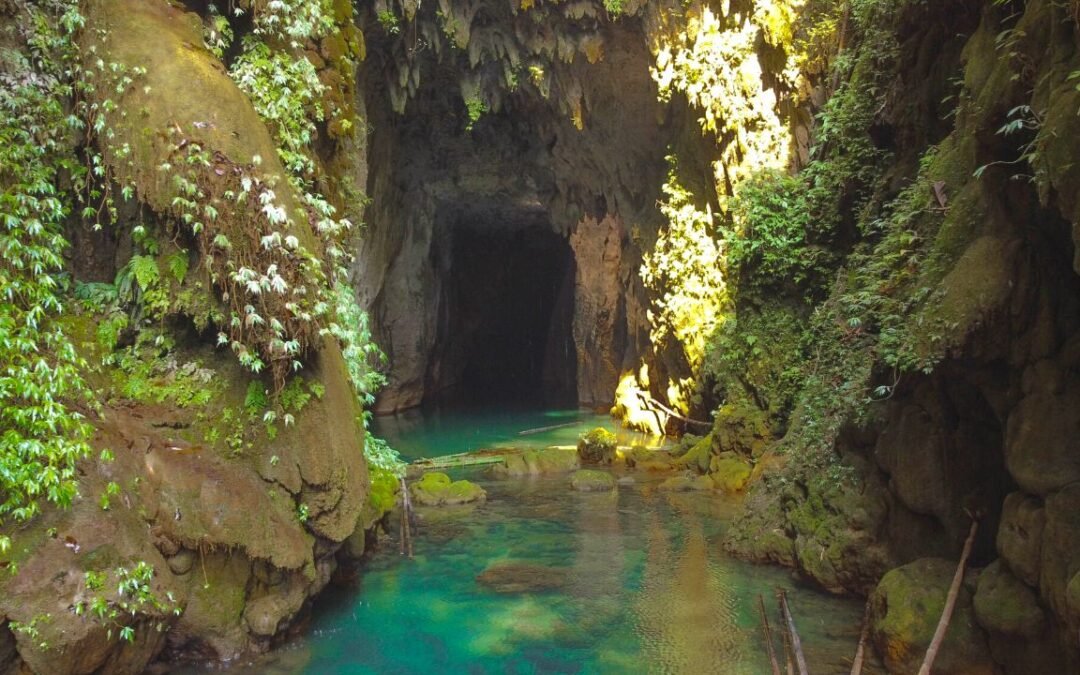
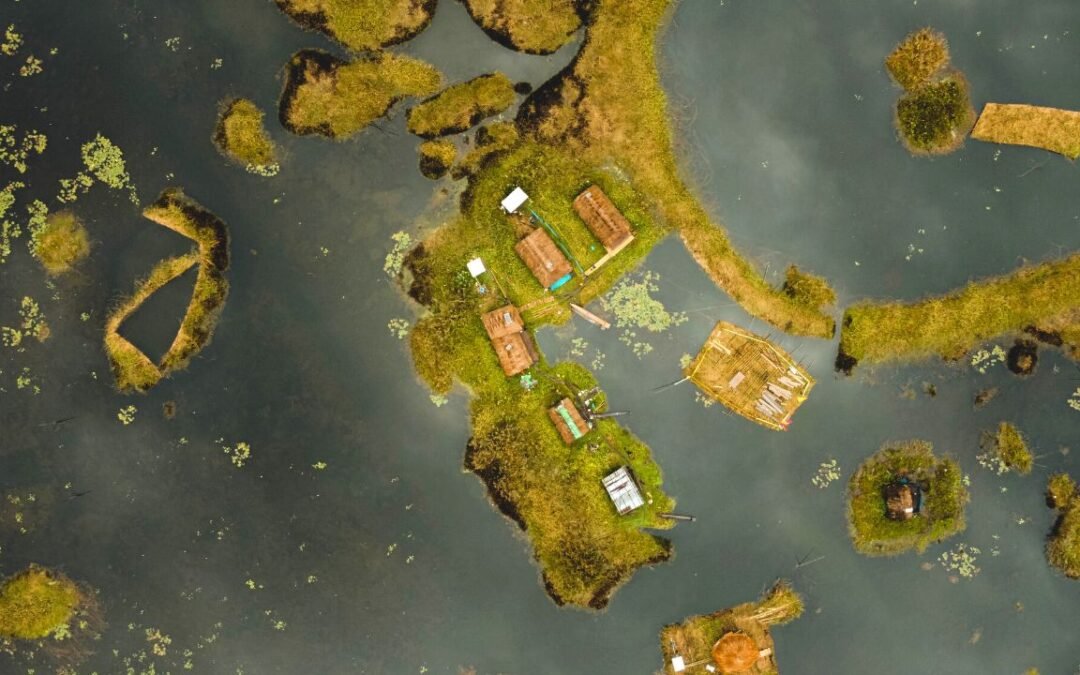
Everytime I read ur post , it gives me so much insight and a zeal to visit the place . And this time you rightly touched my love chord for Arunachal ..your detailed guide on Basar surely will help reader to point yet another untouched beauty in their tourist map .. brilliant post once again .
Thank you Debjani! Its high time you take a trip to Arunachal. And tag me along. 😀
Woah! Bascon seems to be grand in every way. The way you have detailed each and every aspect of the festival and a place is lovely, Amrita 🙂 Your post recreated my memories of attending the festival Nyokum Yullo last year.
I know! Isn’t Arunachal so beautiful? I am planning to visit Nyokum this time. Thank you Anjali for appreciating. 🙂
Such beautiful pictures and you have described each and every essence of the festival. Lovely post as always. I love the Lion Dance and the kid carrying the fish. He is so cute.
Thank you, Yogesh! Yes the kid was really cute and was so ready to give pose for the photographers.
Wow, An amazing experience I have ever read. Trust me I had neither an idea nor heard about this festival earlier but your post provided in depth knowledge. Next time surely visit this. Thank you 🙂
Thank you Pamela. You must visit Basar surely.
Superb writeup. Your posts are so filled with deep insights about the culture and traditions of any festival you’ve been attending. You bring out each and every kittle aspects of the event and out them in the spotlight very well.
Thank you Mohit! You are always kind to me. 🙂
Enjoyed your detailed account of the festival and reliving those fantastic moments at Bascon. It really was a one of its kind festival.
Thank you so much, Sandeepa! It was indeed a pleasure meeting you both.
It’s so amazing, the way you have explained and also the pictures. Also it’s so intriguing that how we still don’t know about many other cultures and festivals from our own country.
Keep writing and sharing, giving us insight on such things.
The Bascon Festival looks absolutely amazing and covers every aspect of culture and life in the region. I would love to visit someday and experience it all.
Thank you Doreen! Do visit and experience this cultural extravaganza.
I must say thanks for introducing festivals that we are not really aware of even being from India. I have never heard of Basar or Bascon. The festival seems lit, especially when there is the confluence of the old and the new. You must have had a great time there in that 3-day festival. This is surely a festival the media should cover.
Yes Shreya, we had a great time. Thank you for appreciating and even we want that these cultural festivals get a lot of coverage.
I have to admit! I envy you for getting such a beautiful cultural extravaganza in Arunachal Pradesh. Northeastern states of India have been on my bucket list for a long time and i wish to visit those states during the harvest season but never got a chance! Coming back to your post, the lion dance intrigued me the most!
Yes, the lion dance had all of us mesmerised. We just kept looking at the performance in awe. Thank you, for the appreciation. 🙂
I’m planning to visit Arunachal Pradesh soon. It will be My first North-East Trip. Their culture looks fascinating. Can’t wait!
Arunachal is a fascinating place too. Hope you have a great time there.
I have never attended a cultural festival and Bascon seems like a great one. What a lovely initiative by the NGO in a lesser known town to put it on the tourist map. I’ve always been intrigued by the culture of North East India and to attend one which displays traditional sports, music and dancing would be a great experience. Thanks for such an informative post!
Thank you, Medha. Yes, the GRK is doing a commendable job in Basar.
I have never heard of the Bascon festival. It is so interesting to learn about cultural festivals around the world, it must have been even more incredible being there! Were there many other tourists there?
There weren’t many tourists around. Mostly locals were present. But, that is the aim of Bascon, to bring in more tourists to this beautiful place called Basar.
I admire this post greatly, it’s not just yet another travel destination – but a place rich with history, culture and a true meaning of travel and exploration. I love how well you’ve highlighted Basar Confluence! Would love to visit during this festive time.
Thank you Yara! Basar is truly a slice of everything.
That’s a pretty interesting festival. If we’re correct, it’s the same in the Cordilleras; the farmers celebrate/hope for a successful harvest. Sometimes when we travel, if we’re lucky, we land right smack in the middle of an important festival. It gives us a glimpse/experience of the country’s culture and history.
Wow, great to know about the festival in Cordilleras. Will look up about that.
I’d never even heard of this, but damn those photos really capture the experience. Great post!
Thank you so much! Glad that you liked the post.
Basar and BASCON continue to tug at our heartstrings. All the lovely memories came flooding back while reading this post. Really there is so much to discover and learn about the Galo culture, that once is not enough. We need to go back again.
I totally agree with you in this one. Basar and Bascon have been priceless.
Basar has never been on our radar before either. Totally would love to see the cool archery at Geppe Abnam. Btw, what was that man doing balancing the arrows?